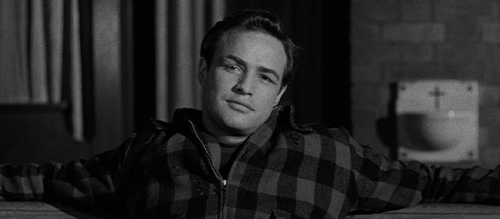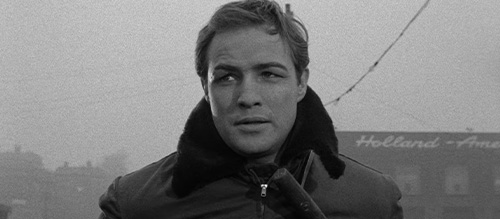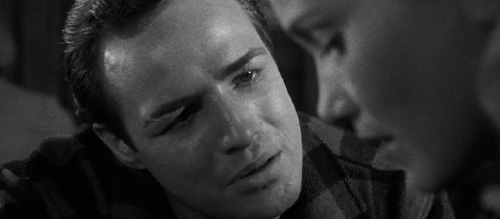I’m With Terry: Marlon Brando’s Method Performance in ‘On the Waterfront’

One of the most popular acting schools in Hollywood is the Method. Popularized in the 1950s, the Method is a way of naturally embodying a role, becoming the person on screen rather than acting like a person. Marlon Brando is often associated with Method performance, and his work in On the Waterfront (1954) won him his first Oscar for Best Actor. But what was it about Brando’s performance that captivated audiences, critics and his fellow filmmakers? Why is his performance still recognized as great to this day? And what can be gleaned from the screen to demonstrate the Method in action?
While Brando was not a student of the prestigious Actors’ Studio, he is still an exemplar of the ideas behind the Method and how they changed film acting for years to come. What distinguished Marlon Brando as a screen actor in On the Waterfront is his training and preparation behind the scenes that led to a unique performance that only he could have given.
On the Waterfront tells the story of a community of dock workers under the thumb of a local crime lord, Johnny Friendly (Lee J. Cobb). The workers play “deaf and dumb” when questioned about events related to Friendly’s more unsavory business. Brando plays Terry Malloy, a dock worker and associate of Friendly’s thanks to his brother’s work for the organization. Terry’s actions lead to the death of a character in the film’s opening, and he struggles emotionally with this throughout the film, especially when he begins spending time with the dead man’s sister.
It’s difficult to watch a performance to see exactly what effect the Method has had on an actor, as every actor’s goal is to fit naturally into the role they are portraying. What is different between the Method and more classical performance techniques is the source of the actor’s emotion, and how they embody the role. Classical performance is about becoming the character, using the experience of that character available within the source material; an “outside-in” approach that disregards the actor underneath in favor of what is required by the role. An actor playing Winston Churchill or Helen Keller would aim to recreate the actions, mannerisms, and tone of such an illustrious figure. The Method, popularized in the United States of America by Lee Strasberg, was more “inside-out”, using improvisation exercises and mental approaches inspired by psychotherapy. Affective memories might inspire an actor’s performance – when playing a scene in which a character is sad, the performer would actively conjure a sad memory that creates a feeling of sadness within the actor. It’s a more “real” way of reacting, by accessing actual emotional states that lead to the appearance of authentic feeling.

Marlon Brando’s style of Method did not come from Strasberg’s teachings, though. His success is attributed to Stella Adler who taught him to be relaxed and to separate himself from the character. “‘Drama depends on doing, not feeling,’ … [which] is to say that acting comes down to movement more than thought. … Thus her training included makeup, voice, mime, acrobatics, and the history of theater.” (Colombani, 10)
This led to a vast difference in performance for Brando across his filmography as he was able to transform into characters through physicality, tone, or makeup. James Naremore notes that his physicality as an actor is what made him stand out in 1950s Hollywood, calling his work a “deviation from the norms of classical rhetoric” with a slouch, mumble, and tendency towards gestures or actions that others might avoid like talking with a mouth full of food in One-Eyed Jacks (1961). (201) His style and training stands out in On the Waterfront, but exactly how is not obvious without that background knowledge.
Like with Vito Corleone in The Godfather, Brando brought his makeup training to the role in On the Waterfront. Terry has a distinct scar on his eyebrow, evidence of his former boxing career and a departure from Brando’s handsome, clean-cut look. Later in the film, Terry is brutally beaten by a group of gangsters. His face is covered in blood that Brando applied himself, and it makes the character distinct outside the age of Code-era Hollywood. The camera is put right in Terry’s face with him centered in the frame to give each of us the full extent of the violence, and Brando’s expression sells Terry’s pain with a mixture of anger, sadness, and desire to continue the fight. Terry’s bloodied walk from the pier is a powerful moment for his character – he staggers like a boxer resisting falling after a knockout blow, exhibiting Terry’s perseverance against the dark forces on the docks. The physical transformation from Brando to Terry to beaten Terry is made clear through the makeup, but it’s Brando’s action that is the real star of the show.

The film presents a contrast within Terry that Brando plays to a tee. There’s the boxer – the tough, dumb guy at the mercy of those around him – and a sensitive young man who feels like a bum because his shot at success was taken from him. An early scene, in which Terry comes to see Johnny Friendly, demonstrates the former. He walks into Friendly’s bar, and Friendly greets him with some mimed boxing. Terry holds back because Friendly is his mob boss, but he gives a little bit of a pose to act as if he’s going along with it. He’s putting up a front and bringing his experience as a boxer into the stance he takes as Johnny approaches him. Friendly picks Terry up, and Terry walks off frame looking uncomfortable and shifting into a slouch, showing that Terry doesn’t like how their physical rapport recreates their power dynamic. There are layers to what Brando puts into Terry as he reacts to Johnny Friendly’s various actions, showing Terry’s background, feelings about the other characters, and how people act with multiple dimensions of thought. For Brando, acting is something we all do every day, and the question is how to express the different feelings someone has within a given situation because people are never just one thing.
Later on, Terry rescues Edie (Eva Marie Saint), the sister of the man whose death he feels responsible for, from a group of mobsters. He stands with his hands folded at his belt as he sees Edie off. A former dock worker recognizes the pair, and Terry gets physical with the man as he begins to talk about the dead man, a harsh switch from his non-threatening pose only moments before. Terry and Edie begin to chat about her brother and the convent she attends. Terry tells her not to be afraid of him, and one of the film’s most famous improvisations occurs when Terry retrieves Edie’s dropped glove. He picks up the glove, brushes dirt off of it, and places it on his hand while sitting on a swing set. It’s an image that demonstrates Terry’s innocence, his helpful, almost childlike nature that rests at his core. Terry is curious in their discourse, and Brando demonstrates this with his glances and inquisitive intonation. Terry has traded in the boxing gloves, a symbol of his tough front, for Edie’s glove, and the act of placing it on his own hand shows a desire for a more romantic self. It’s an embracing of the more traditionally “feminine” qualities of his character. It’s a brilliant moment that, when taken in concert with his mimed boxing and bloodied face, gives a full picture of the role of Terry.
While many associate Marlon Brando with Strasberg’s approach of the internal brought to the forefront, his acting style is not so simply defined. His Method brings together many traditions that focus on losing yourself physically within a character’s mindset and expressing that internal self outward. Without Brando’s particular training and style of acting, Terry might have been played without so much nuance. It can be easy to fall into cliches with a dumb tough guy character, but Brando’s ability to show the nuances of Terry Malloy take him from a potential stereotype to a well-fleshed out character by way of performance. Even if it cannot be easily picked off the screen by a viewer, there is no doubt that Method acting comes through in the screen performances of Marlon Brando.
Bibliography
Colombani, Florence. Anatomy of an Actor: Marlon Brando. Translated by Lucy McNair and Brandon Hopkins, English translation, Phaidon Press Limited, 2013.Naremore, James. Acting in the Cinema. First edition, University of California Press, 1988.

